Effects of Altitude Change on Nutritional Quality and Elymus nutans Regularity in Qinghai-Tibet Plateau
He Jing-lei, Zhou Yan-tong, Kong Ling-ze-lai, Li Bing, Yu Jin-qiu, Gong Hao, Sun Xue, and Cui Guo-wen
College of Animal Sciences and Technology, Northeast Agricultural University, Harbin 150030, China
Abstract: In order to reveal the effects of different altitudes on the nutritional quality of wild forage in Qinghai-Tibet Plateau, this study used Elymus nutans as the tested plants to evaluate the changes of nutrient contents and the correlation between the nutrient contents and altitudes. Four sampling sites were set up at altitudes of 2 562, 2 660, 2 775 and 2 905 m with the vertical distance among each sampling point was about 100 m. The results showed that the crude protein, ash and phosphorus contents of Elymus nutans decreased significantly with an increase in altitudes. The crude protein contents decreased by 1.87 % with each 100 m increase in altitudes. The variation rule of crude protein contents with altitudes in the simulated curve was "y= –0.0187x+63.244 (R2=0.9557)".The crude ash contents decreased by 1.77% with each 100 m increase in altitudes. The variation rule of crude ash contents with altitudes in the simulated curve was "y= –0.0177x+56.144 (R2=0.978)". Neutral detergent fiber (NDF) and acid detergent fiber (ADF)showed an overall increasing trend with the increase of altitudes, but the most obvious increase was at 2 775 m. The contents of crude fat and Ca did not change regularly with altitudes.
Key words: Elymus nutans Griseb., Qinghai-Tibet Plateau, nutritional quality, grey correlation analysis
Introduction
In recent years, with the proposal of the "changing grain to forage" policy and the rapid development of grassland husbandry in China, pasture and forage crops play an increasingly important role as the basis for the development of animal husbandry (Zhanget al., 2019). The Qinghai-Tibet Plateau is located in the southwest of China, with an area of about 2.53×106km2and an average altitude of over 4 000 m. It is one of the five pastoral areas in China (Xieet al.,2003), and it is also an important ecological protection barrier in China (Zhaoet al., 2017). However, the grassland in this area is low and sparse, and the forage yield is low. In addition, in recent years, the frequent human activities, the increasing number of livestock and unreasonable grazing activities have caused serious degradation of grassland, and even serious desertification and soil erosion. The increasingly prominent contradiction between inadequate forage supply and herbivorous livestock makes the already fragile ecological environment more unbearable(Yanget al., 2012). Therefore, the implementation of artificial grass planting has become an important measure to coordinate the development of local animal husbandry and ecological environment security.The cultivation of good forage varieties is of great significance to alleviate the contradiction between grassland and livestock and safeguard national unity.
Elymus nutansis a perennial high-quality forage of Gramineae. It possesses the advantages of drought resistance, cold resistance and high feeding value. It is widely distributed in the areas below 3 000 m above sea level in the Qinghai-Tibet Plateau. Because the Qinghai-Tibet Plateau belongs to the plateau mountain climate, it has the characteristics of long sunshine time,strong solar radiation, low temperature, less rainfall,low gas partial pressure and short growth cycle (Wuet al., 2009). Vegetation is required to complete its life cycle in a shorter growth period and accumulate enough nutrients to survive the cold and long winter. In addition, the change of elevation gradient involves the difference in environmental factors, such as light, heat,water and air. These factors affect seed germination,plant growth and development, material metabolism and structural function, and ultimately affect crop yield and nutritional quality (Khawajaet al., 2016; Wenet al., 2017). Therefore,Elymus nutanswas studied in this experiment. The contents of crude protein, crude fat, neutral detergent fiber, acid detergent fiber, crude ash, calcium and phosphorus were measured to explore changes in the nutrient composition ofElymus nutansat different altitudes. In order to avoid the singularity of a single index evaluation, this paper applied the grey correlation method (Zenget al., 2018) to evaluate it comprehensively. In conclusion, this paper was trying to find the most suitable altitude for growth in the Qinghai-Tibet Plateau, and provide a theoretical basis for cultivating new high-quality forage varieties and guiding local forage production.
Materials and Methods
Study site
The experimental site is Huangzhong County, Xining City, Qinghai Province. The experiment is situated in the eastern part of the Qinghai-Tibet Plateau. The climate in this area is semi-arid in a plateau, mainly in mountain and valley landforms, with an average annual temperature of 2.8-5.7℃, annual precipitation of 527-681 mm and a frost-free period of 172 days.The experiment was carried out in Huangzhong County (36°21'- 36°26'E, 101°42'- 101°46'N) at an altitude of 2 500-3 000 m. For each 100 m rise of the coastal elevation gradient, four sampling sites were set up, as shown in Table 1.

Table 1 Sampling sites
Sampling method
Samples ofElymus nutansat the flowering stage were collected in July, 2015. Three natural habitat communities were randomly selected at each sampling point, and 1 m×1 m samples were randomly selected.Cut samples on the same ground. The collected pasture was dried and crushed by a crusher, then sifted by 40 meshes and packed in a sealed bag for storage in a dry place.
Measuring indicators and methods
Samples were analyzed for crude protein, crude fat,neutral detergent fiber (NDF), acid detergent fiber(ADF), crude ash, calcium (Ca) and phosphorus (P).Crude protein content was determined by Kjeldahl nitrogen analyzer, crude fat content by Soxhlet ether extraction, neutral detergent fiber (NDF) and acid detergent fiber (ADF) content by normal detergent fiber analysis, and crude ash content by ignition. The content of calcium was determined by the potassium permanganate titration method and the content of the total phosphorus was determined by the molybdenum antimony anti-colorimetric method.
Data statistics and model development
The experimental data were preliminarily analyzed and collated by Excel 2016 software. The experimental data were analyzed by ANOVA using SPSS 20.0 software, and multiple comparisons were performed by Duncan method. Used SigmaPlot 12.5 to draw a graph.
The grey correlation method was used for the comprehensive evaluation of data. Firstly, the optimal value of each test index was selected to set ideal values, and the initial value processing was adopted to make each index non-dimensionalized, and a new series between 0 and 1 was obtained, that was, all the data were divided by the expected indexX0(the crude fiber content was inversely related to the digestibility,so the indicator took the reciprocal of the quotient).Then, the normalized values of the ideal values of the indicators were respectively subtracted from the normalized values of the corresponding indicators of each altitude. A series of standard absolute deviations were obtained. The secondary minimum difference and the secondary maximum difference were:

In the test,Xiwas a comparison series.i=1, 2, 3, 4(four altitude gradients),kwas the seven traits of the measurement indexes,Xi(k) was the trait value of thek-th indicator of thei-th breed, andk=1, 2, 3...7,X0(k)was the trait value of thek-th indicator of the reference species.
According to the correlation coefficient formula,each absolute difference was substituted, and the corresponding correlation coefficient was obtained.ρwas the resolution coefficient, and the value was between 0 and 1, which was generally 0.5.

Calculated the degree of correlationδamong each altitude and the ideal value according to the correlation degree formula. The degree of association was an equal degree of association. Since each nutritional indicator had different degrees of importance in the evaluation process. For the objective reaction evaluation result, the weightWKwas given according to the importance of various nutrients, and the weighted degree of associationγiwas calculated.

In the model,nwas the number of nutritional indicators (this test was 7), andξiwas the correlation coefficient ofX0andXiat thek-th point.
Results
Effects of altitudes on crude protein contents of Elymus nutans Griseb.
There were significant differences in the crude protein contents ofElymus nutansat different altitudes(p<0.05) (Fig 1.). With the increase of altitude, the crude protein contents ofElymus nutansdecreased.Among them, the crude protein contents decreased significantly at 2 775 m, which was 2.58% lower than that at 2 660 m. At 2 905 m, the crude protein content was the lowest, which was 6.22% lower than that at 2 562 m. The crude protein contents of the simulated curve varied with altitude:y=–0.0187x+63.244(R2=0.9557). That was the crude protein content decreases by 1.87% points for every 100 m elevation.
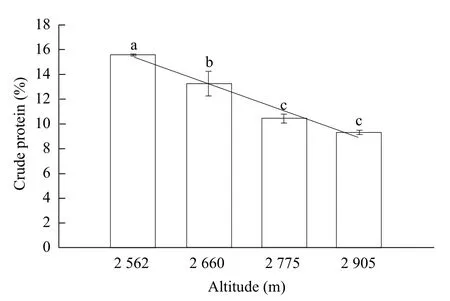
Fig. 1 Crude protein contents of Elymus nutans at different altitudes
Effects of altitudes on crude fat contents of Elymus nutans Griseb.
On the analysis of the change in altitudes, the crude fat contents ofElymus nutansshowed no significant difference (Fig. 2). The contents of crude fat showed a tendency to fluctuate as the altitude increased. At 2 660 m,Elymus nutanshad the highest crude fat content of 2.70%. At 2 775 m,Elymus nutanshad the lowest crude fat content of 2.33%.
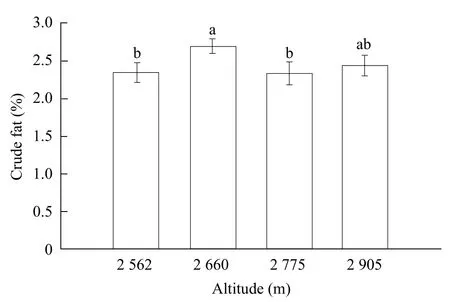
Fig. 2 Crude fat contents of Elymus nutans at different altitudes
Effects of altitudes on NDF contents of Elymus nutans Griseb.
With the increase of altitude, the overall NDF contents ofElymus nutansincreased first and then decreased(Fig. 3). In the range of 2 562-2 775 m above the sea level, NDF contents ofElymus nutansincreased gradually with increasing altitude. At 2 775 m, NDF content was the highest, at 62.20%, which was 6.25%higher than that at 2 562 m. In the range of 2 775-2 905 m, NDF contents ofElymus nutansdecreased gradually with the elevation. At 2 905 m, NDF content decreased to 57.85%, but its NDF content still increased by 1.89% compared with that at 2 562 m.
Effects of altitudes on ADF contents of Elymus nutans Griseb.
There was no significant difference in ADF contents ofElymus nutanswith an altitude gradient, but there was a tendency to fluctuate (Fig. 4). ADF content was the highest at 2 775 m, which was 3.89% points higher than that of the lowest 2 660 m's. There was a downward trend at 2 775-2 905 m, but it was still 1.64%higher than that at 2 660 m.

Fig. 3 NDF contents of Elymus nutans at different altitudes
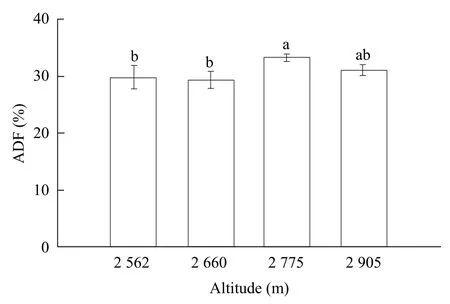
Fig. 4 ADF contents of Elymus nutans at different altitudes
Effects of altitudes on crude ash contents of Elymus nutans Griseb.
There were significant differences in the crude ash contents ofElymus nutansat different altitudes (p<0.05) (Fig. 5). As the altitude increased, the crude ash contents ofElymus nutansgradually decreased.Among them, the reduction of coarse ash contents at 2 775 m was the most obvious, which reduced 2.8%sharply compared with 2 660 m's. At 2 905 m above the sea level,Elymus nutanshad the lowest crude ash content of 4.85%, which was 5.8 % lower than that at 2 562 m. The variation curve of the crude ash content with altitude changes was:y=–0.0177x+56.144(R2=0.978), that was, the crude ash content decreased by 1.77% for every 100 m elevation.
Effects of altitudes on Ca contents of Elymus nutans Griseb.
In the range of 2 562-2 905 m, Ca content ofElymusnutanssamples did not change significantly with the increase of altitude (Fig. 6). Ca contents decreased first and then grew up with an increase of altitude. The highest Ca content at 2 905 m above the sea level was 0.70%. At 2 660 m above the sea level, the calcium content was the lowest at 0.55%.

Fig. 5 Crude ash contents of Elymus nutans at different altitudes
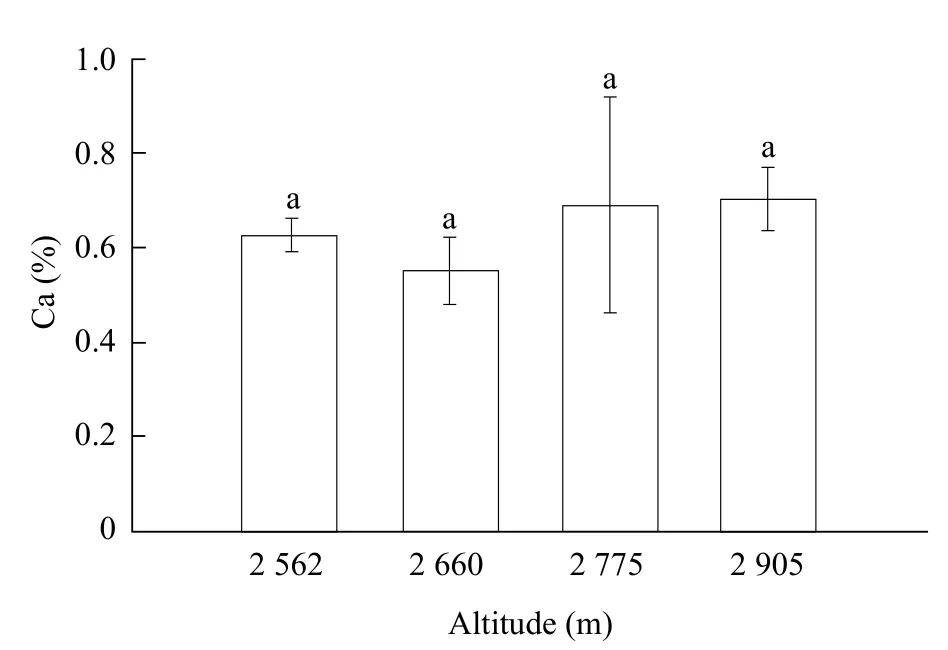
Fig. 6 Ca contents of Elymus nutans at different altitudes
Effects of altitudes on P contents of Elymus nutans Griseb.
In the range of 2 562-2 775 m, P contents ofElymusnutansdecreased significantly with the elevation (p<0.05) (Fig. 7), but there was no significant difference in the range of 2 775-2 905 m. P content at 2 775 m above the sea level was 0.20%, which was 0.18% lower than 0.37% at 2 562 m. P content got the lowest point at 2 905 m above the sea level, which was 0.17%.
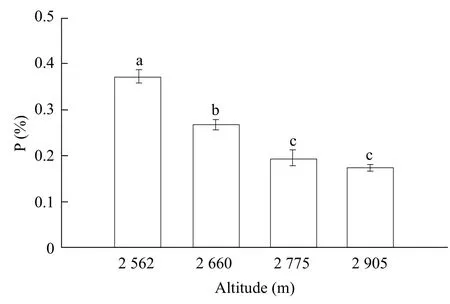
Fig. 7 P contents of Elymus nutans at different altitudes
Grey correlation analysis
Gray correlation analysis was used to comprehensively evaluate the crude protein, crude fat, neutral detergent fiber, acid detergent fiber, crude ash, calcium and phosphorus contents ofElymus nutansat different altitudes. First, the nutrient indicators were initialized to obtain dimensionless data (Table 2), which was followed by calculating the second-order minimum difference and the second-order maximum difference,0.0139 and 0.5634, respectively. According to the correlation coefficient formula, the correlation coefficient of each indicator in different regions was calculated(Table 3). Further calculations were made to obtain the equal weight correlation and weighted incidence degree, and the data were sorted by numerical value(Table 4).

Table 2 Dimensionless of nutritional data

Table 3 Correlation coefficient of nutritional parameters

Table 4 Correlation degree of nutrient components of Elymus nutans in different altitude regions
The greater the degree of correlation, the closer it was to the ideal value, the better the nutritional value ofElymus nutansin this area. The results of the equal weight correlation and weighted incidence degree of the nutrient data in the four altitude regions were the same, both of which were 2 562 m>2 660 m>2 905 m>2 775 m (Table 4). The results showed that with the increase of altitude, the nutritional value ofElymus nutansdecreased, and reached the bottom at 2 775 m.
Discussion
The value of pasture depended not only on its biological yield, but also its nutrient content. At present, the main chemical analysis indicators of hay quality commonly were used in various countries including crude fiber, crude protein and energy(Jensenet al., 2016), and the differences in nutrient composition were largely affected by environmental factors. There were huge differences in the ecological environment at different altitudes. As the altitude increased, the temperature, gas partial pressure drops,light and ultraviolet radiation increased. In order to adapt to the harsh environmental stress, the plants were improved on their antioxidant capacities and regulated the metabolism of substances in the body by changing their morphological structures, which could lead to dramatic changes in biomass and nutrients.
Crude protein was an essential nutrient for livestock and one of the most important indicators for evaluating and identifying the quality of pasture. Crude protein was mainly composed of pure protein and non-protein nitrogen-containing substances. The higher the crude protein content, the better the nutritional quality of the forage (Sun, 2016). Therefore, increasing protein content was an important measure to improve the quality of pasture. In addition, the interaction between growing season and the environment could also affect the nutritional quality of plants (Jameset al., 2017). In areas with a cool climate, abundant sunshine, suitable temperature and large temperature difference between day and night, it was suitable for photosynthesis of plants, which was conducive to the accumulation of amino acids. However, at high altitudes, climatic factors exceeded their optimal thresholds, which hindered amino acid synthesis (Songet al., 2008). In addition, changes in protein contents were also affected by genotypes, environmental factors and genotypeenvironment interactions (Bharathet al., 2014). In this experiment, the crude protein contents ofElymus nutansdecreased with elevation. This conclusion was the same as that of Cheng (2012) and Zhanget al.(2017) who made the study ofElymus nutansin the area of 2 900-3 800 m above the sea level. However,the study on Tianzhu with high altitudes of 2 965,3 763, 4 228 and 4 752 m showed that the crude protein contents ofElymus nutansincreased with altitude.This might be caused by different greening periods and length of the growing seasons of pasture at different altitudes. Studies had shown that the crude protein contents in crops such as corn (Lv, 2008) and buckwheat (Xuet al., 2017) increased with altitude,and the crude protein contents in flue-cured tobacco(Fuet al., 2007) decreased with increasing altitude.It could be seen that the crude protein contents of the plants did not have an optimum altitude for the same or different plants. The optimum altitude was related to factors such as ecological climate, soil environment,forage growth period and cutting height.
Crude fat content was an important indicator of forage nutrition. As an important source of energy supplied and fatty acid source, crude fat provided heat for pasture and it was also one of the essential nutrients for animal growth and development (Sumczynskiet al., 2015). Gaoet al. (2013) showed that the crude fat contents of flax increased with the increase of latitude. The results of studies on the protein and fat contents of soybean (Wanget al., 2006) and corn (Luanet al., 1988) showed that the conditions favorable for protein formation were not conducive to the formation of fat. Although the crude fat contents in this experiment did not differ significantly with the elevation, it showed an upward trend of fluctuation, which was consistent with the above research results.
Crude fiber was one of the main energy sources.NDF content was negatively correlated with livestock dry matter intake, and ADF contents affected livestock digestibility (Ja, 1995; Li, 1997). Latitude and altitude were negatively correlated with the concentration of legume herb fiber, which might be related to temperature. These differences might have important effects on the fiber digestibility of ruminants (Dehaanet al., 2003; Roukoset al., 2011). Thus, to a certain extent, the lower the fiber contents, the better the quality of the pasture. In this study, NDF and ADF contents fluctuated with the increase of altitude,indicating that the high-altitude growth ofElymus nutanswas not conducive to livestock feeding and digestion.
The coarse ash contents reflected the absorption of soil minerals during the growth of forage, and the high contents indicated that the plant had good nutritional quality (Ayubet al., 2012). The crude ash contents in this test decreased with increasing altitude.Calcium and phosphorus were two important mineral elements necessary for livestock and poultry. It had the function of promoting bone development of livestock and poultry and maintaining normal physiological functions of the body. In this experiment, there was no significant difference in the calcium contents ofElymus nutansin the altitude gradient, and the total phosphorus contents decreased with increasing altitude. Grey correlation analysis was a dynamic comparison of a system that developed and changed.The influence of one factor on others in a changing system might change as the ecological environment changes. This study analyzed the nutritional quality of pasture at different altitudes by grey correlation. The results showed that the nutritional quality of forage decreased with the elevation, and the nutritional quality ofElymus nutanswas the lowest at 2 775 m above the sea level.
Conclusions
In summary, in the Qinghai-Tibet Plateau, the climate environment became worse and worse with the elevation, which made the crude protein, crude ash and P contents ofElymus nutansa downward trend.The contents of NDF and ADF increased first and then decreased, while the contents of crude fat and Ca did not change significantly. The comprehensive evaluation results showed that with the increase of altitude, the nutritional quality ofElymus nutansdecreased. At 2 775 m,Elymus nutanshad the lowest nutritional quality and significant changes in various nutritional indicators. If further analyzed the light,soil and climate of the region, it could provide a good theoretical basis for the breeding of fine forage species in the Qinghai-Tibet Plateau.
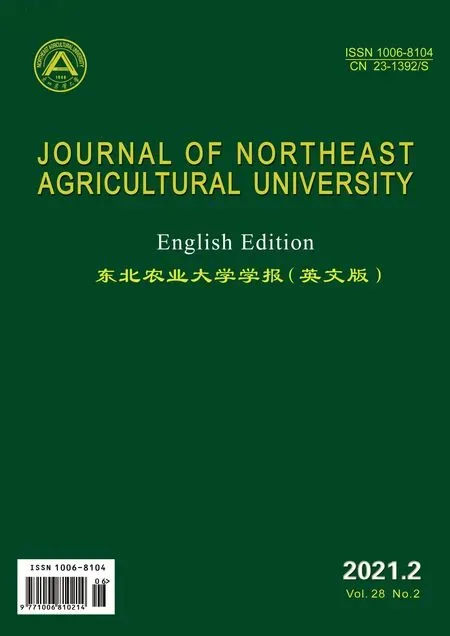 Journal of Northeast Agricultural University(English Edition)2021年2期
Journal of Northeast Agricultural University(English Edition)2021年2期
- Journal of Northeast Agricultural University(English Edition)的其它文章
- Identification of QTLs Associated with Resistance to Pseudomonas syringae pv. Glycinea in Soybean (Glycine max (L.) Merr)
- Development of an Artificial Diet for Effective Oral Delivery of dsRNA to Soybean Pod Borer, Leguminivora glycinivorella (Lepidoptera: Tortricidae)
- Grain Yield and Nitrogen Use Efficiency of Hybrid Rice in Response to High Plant Density and Nitrogen Rate
- Index Design and Comprehensive Evaluation of Germplasm Resources of Fruits Based on Mathematical Model of AHP and FCE: Sterculia nobilis Smith as a Case
- Effects of Interaction of Soil Moisture and Organic Matter on Powdery Mildew Disease and Growth of Heracleum moellendorffii Hance
- Comparative Analysis of Bacillus thuringiensis Vip3Aa57 and Vip3Aa62 Insecticidal Activities
